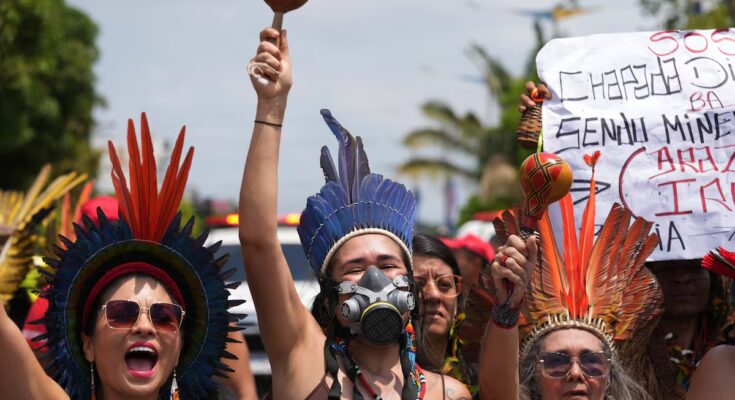Starting this Monday, the Amazonian city of Belém faces the final part of the annual climate summit, COP30, held under the auspices of the United Nations. From this moment on, ministers from some of the nearly 200 countries that usually participate in these negotiations will begin to take control of the discussions in the Brazilian city. Between Monday and Tuesday, representatives of around 150 countries, mostly ministers, will participate in the plenary session of the conference.
The summit began on November 10 and, in principle, should end on the 21st, although the closing of these meetings is always delayed by hours or days due to the complexity of the negotiations. This year’s event must serve as a thermometer of the international fight against climate change in a context of extreme questioning of multilateralism. These are some of the keys to the conference.
The most complicated moment
The Belém Summit is the thirtieth COP held since the United Nations Framework Convention on Climate Change was adopted in 1992. From this general framework emerged first, in 1997, the Kyoto Protocol, and then the Paris Agreement, which this year celebrates its tenth anniversary since it was signed at the COP held in the French capital in 2015.
But this year’s summit comes at the worst time in the international climate fight in at least a decade. The advance of ultra-conservative governments, which in many cases align themselves with denialism, is influencing climate and environmental policies. At the head of all is the government of Donald Trump, who is not participating in the Belém summit and who has pulled his country out of the Paris Agreement, which will materialize in January. Furthermore, in various international forums it maintains a threatening attitude towards countries that want to carry out measures against climate change. Proof of this complicated moment is the lack of participation of leaders in the previous mini-summit, at the beginning of COP30 a week ago, organized by the Brazilian government.
National climate plans
The Paris Agreement aims to reduce human-made greenhouse gas emissions in such a way that the climate change they cause remains within safe margins. Specifically, the goal set was to not exceed 2 degrees Celsius of warming compared to pre-industrial levels, and as far as possible 1.5 degrees.
To achieve this objective, the agreement provides that all countries that have ratified it, almost 200, must present plans to reduce their emissions, known by the acronym NDC.
The first round of these plans, which contain promises up to 2030, did not require countries to meet warming levels that remain below 1.5, nor 2. The second round focuses on emissions reduction targets up to 2035. And it doesn’t even straighten the path.
Off target by 1.5 degrees
This second NDC was supposed to be presented in February 2025. But virtually no country has done so. Finally, 114 – only 60% of those who ratified the Paris Agreement – sent it to the UN, many of them once COP30 began. According to UN calculations, the sum of the NDCs (if actually met) would lead to a 12% reduction in emissions in 2035 compared to 2019 levels. To reach the 1.5 target this reduction would have to be 55%, four and a half times higher than what is foreseen by these national plans. For the 2 degrees objective, the reduction by 2035 should be 35%, three times higher than that established in the NDCs presented by the Governments.
UN calculations suggest that if the latest NDCs are met, warming could remain around 2.5 degrees, but this is an estimate full of uncertainties.
All this is what could happen with national promises, what has actually happened in recent decades is that emissions have not stopped growing almost every year. Those of the main greenhouse gas, carbon dioxide, will also do so in 2025, according to the experts who draw up the Global Carbon Budget. In fact, scientists believe that the 1.5 degree threshold will be permanently exceeded in the next decade. The only possibility that would remain would be to make this overshoot temporary and then be able to reduce it through the elimination of other greenhouse gases, such as methane, and the uncertain techniques for capturing and storing carbon dioxide from the atmosphere. In any case, every tenth of a degree of warming avoided will reduce the impacts of this crisis.
What can come out of Belém?
During these three decades of negotiations and summits, the focus has been on greenhouse gas emissions, but not on the main causes: oil, gas and coal. Many of the negotiating countries are large exporters of these fuels and are precisely those who advocate that the measures focus on gases and not on limiting the consumption of fuels that cause emissions.
At the Dubai climate summit, held in 2023, there was a direct mention of fuels for the first time at the end of the event, where oil, gas and coal were called for to be left behind. But the following year, at the Baku summit, no reference to these fuels was found.
In the leaders’ mini-summit before the COP, Brazilian president and host of the conference, Luiz Inácio Lula da Silva, expressed the need for a roadmap to, among other things, “overcome dependence on fossil fuels.” This invitation has been accepted by several countries, such as the United Kingdom, Germany, France and Colombia, who are pushing for this topic to enter the debates in Belém, something that was not foreseen in the official agenda.
This roadmap concentrated some of the discussions in the first week of the summit. In a COP without a clear focus – the previous one, for example, was completely focused on climate finance from rich countries to those with fewer resources – it can become the main battle. It should be remembered that the decisions of these conferences are adopted with the consensus of all negotiators, which causes the debates to continue endlessly.
Protests and democracy return
Lula’s words in favor of this path to leave fuel behind contrast with those of Azerbaijan’s president, Ilham Aliyev, just a year ago at the opening of COP29 in Baku. The host described fossil fuels, on which his country largely lives, as “a gift from God”. The presidency of each summit has a very important role in how the negotiations are guided and in the themes that gain strength in the meeting. And there was no mention from Baku of the need to distance ourselves from the main causes of the problem.
The location of each conference rotates each year in different regions of the planet. And it is the countries of each of these regions that will have to agree on the choice of the place where they will be held. This meant that the three previous ones in Belém were carried out in non-democratic countries such as Egypt, the United Arab Emirates and Azerbaijan. Now Brazil has returned to a democracy, and this had a first consequence: activists were able to demonstrate freely again in the streets of the host city to demand measures against climate change three years later. The large march, which brought together thousands of people, took place this Saturday and was led by representatives of the indigenous peoples.
At the Belém summit, another dilemma will also need to be resolved, which once again has the debate between authoritarianism and democracy at its centre: where will COP31 be held? Turkey and Australia are fighting to host him, but there is currently no agreement.
Disinformation and denialism
The advance of the far right, which is marking the international fight against climate change as well as promoting authoritarianism, is in many cases closely related to climate denialism. This denial, which gains power even though we are at a time when the scientific evidence for climate change is strongest and the effects of warming are more evident than ever, is in turn linked to misinformation.
Warnings against denialism and disinformation were also very present in Lula’s speeches at this conference. And last week Brazil, Canada, Chile, Denmark, Finland, France, Germany, Spain, Sweden and Uruguay joined a statement, also sponsored by the United Nations and UNESCO, warning of the “growing impact of misinformation, disinformation, denialism, deliberate attacks against environmental journalists, advocates, scientists, researchers and other public voices, and other tactics used to undermine the integrity of climate change information.” The signatories have pledged to fund projects that counter these practices and to ask tech companies to “evaluate” whether the design of their algorithms contributes “to undermining the integrity of the climate information ecosystem”.



